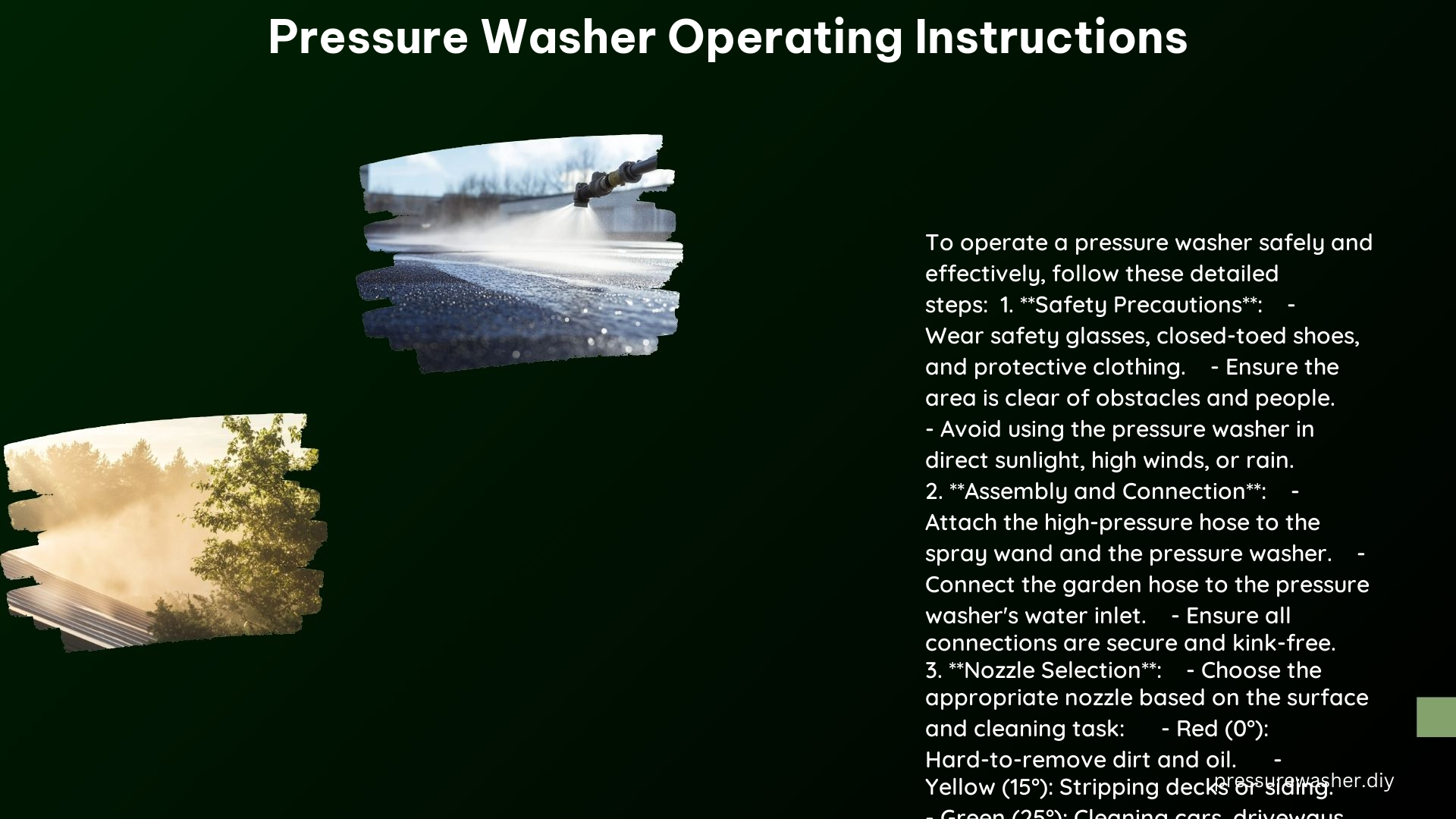Pressure washers are powerful cleaning tools that can effectively remove dirt, grime, and stubborn stains from a variety of surfaces. However, operating a pressure washer requires proper safety precautions and a thorough understanding of the equipment. This comprehensive guide will walk you through the step-by-step instructions for safely and effectively using a pressure washer.
Safety Precautions
Wear Protective Gear
- Safety glasses: Protect your eyes from debris and high-pressure water spray. Choose glasses with shatterproof lenses and a wraparound design for maximum protection.
- Closed-toed shoes: Wear sturdy, slip-resistant shoes to prevent injury from the pressurized water stream.
- Protective clothing: Wear clothes that can get dirty and wet, such as long pants and a long-sleeved shirt, to protect your skin from the high-pressure spray.
Prepare the Area
- Remove obstacles: Clear the area of any furniture, plants, or other items that could be damaged by the pressure washer.
- Sweep the surface: Sweep the area to remove any loose debris, rocks, or dirt that could be propelled by the high-pressure water.
- Ensure safety: Keep pets and children away from the work area to prevent accidental injury.
Check the Weather
- Avoid windy conditions: Strong winds can cause the water spray to become unpredictable and potentially dangerous.
- Opt for sunny days: Working in direct sunlight will provide better visibility and control over the pressure washer.
Setting Up the Pressure Washer

Assemble the Wand
- Twist the wand and trigger handle together securely, ensuring a tight connection.
Connect the High-Pressure Hose
- Attach one end of the high-pressure hose to the trigger handle and the other end to the brass connection on the pressure washer.
- Hand-tighten the connections to prevent leaks.
Connect the Garden Hose
- Attach the garden hose to the pressure washer’s water inlet.
- Ensure all connections are tight to prevent water leaks.
Select and Attach the Nozzle
- Choose the appropriate nozzle for your project:
- 0-degree nozzle: Ideal for removing stubborn dirt and grime
- 25-degree nozzle: Suitable for cleaning dirt and debris
- Attach the selected nozzle to the spray wand.
Operating the Pressure Washer
Start the Pressure Washer
- For gas-powered models:
- Add oil and fuel to the engine.
- Set the fuel valve to the “open” position.
- Turn on the switch and set the choke lever to the “full start” position.
- Pull the starter rope and let the engine run for 10 seconds before moving the choke to the “run” position.
- For electric models:
- Plug the pressure washer into a grounded electrical outlet.
- Turn on the power switch.
Test the Nozzle
- Start on the lowest pressure setting to avoid kickback.
- Squeeze the trigger for about one minute to release any excess air in the system.
- Adjust the nozzle as needed to achieve the desired spray pattern and pressure.
Clean the Surface
- Hold the nozzle tip about 4-5 inches away from the surface you’re cleaning.
- Use slow, overlapping strokes to cover the entire area.
- Move the nozzle closer for tougher stains or stubborn dirt.
Shutting Down the Pressure Washer
Release the Trigger
- Turn on the safety lock to prevent accidental spraying.
Turn Off the Water Source
- Ensure the main water source is turned off before detaching the garden hose from the pressure washer.
Turn Off the Safety Lock
- Pull the trigger to release any remaining water and pressure in the system.
Detach the Hose
- Carefully disconnect the garden hose from the pressure washer’s water inlet.
- Store the hose and pressure washer in a dry, indoor area.
Additional Tips
- Use the right detergent: Only use detergents specifically designed for pressure washers to avoid damage to the equipment or the surface you’re cleaning.
- Clean the detergent container: Fill the container with water and spray until empty to remove any leftover detergent.
- Start with low pressure: Begin with the lowest pressure setting and gradually increase as needed to avoid damaging the surface.
Technical Specifications
Pressure Washer Types
- Electric models: Typically range from 1,300 to 2,000 PSI (pounds per square inch) and 1.2 to 1.8 GPM (gallons per minute).
- Gas-powered models: Offer higher pressure and flow rates, ranging from 2,000 to 4,000 PSI and 2.0 to 4.0 GPM.
Nozzle Types
- 0-degree nozzle: Delivers a concentrated, high-pressure stream for removing stubborn dirt and grime.
- 25-degree nozzle: Provides a wider, fan-shaped spray pattern for general cleaning of dirt and debris.
Safety Features
- Some pressure washers come equipped with GFI (ground fault circuit interrupter) plugs to protect against electrical shock and electrocution.
